Mulberry sauce might sound like dessert, and it could be, but this sweet and sour sauce flecked with aromatic herbs is a nice change of pace from typical jams and preserves . You can use the basic method with plenty of other dark fruits to serve with chicken, pork or game, too.
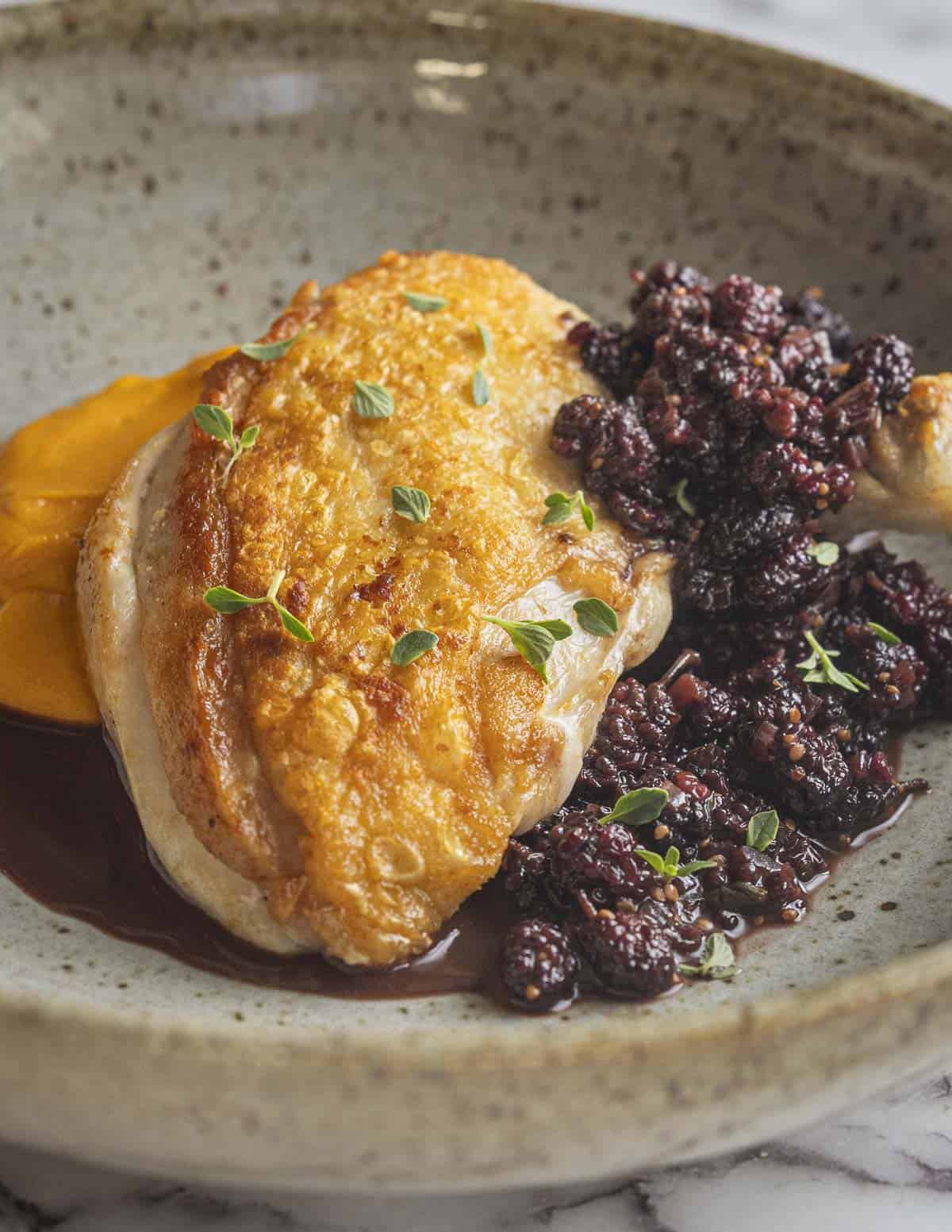
I found the recipe in my files from the first kitchen I ran. After I taught my dishwashers to pick the ornamental fruit around the restaurant, my dishwasher Pedro started to bring me feral mint and mulberries from the parking lot of his apartment.
I'm demonstrating this as a restaurant pan sauce, but I make similar sauces in larger batches for sliced roasts and grilled meat like pork chops too. At home it's a good use for those small quart bags of fruit bumping around in the freezer. On that note, if you have a few pounds of fruit, print off my recipe for mulberry pie right now.
Chefs Tips
- For the sauce to succeed it needs to be slightly tart and should be tasted multiple times to ensure it's balanced. You can also add a spoonful of whole grain mustard to season and thicken it.
- Crushing the fruit in the pan helps the sauce become thick and homogenous.
- Fruit sauces are a great place to layer flavors. Spiciness, like adding a finely minced hot pepper, black pepper or grated fresh ginger can give it depth.
- Fruit sauces are great places for leaves or slices of herbs like lemon verbena, mint, lemongrass, tarragon, basil or lemon thyme (pictured).
- To ensure the sauce is thick you can add a spoonful of jam or preserves.
- I use homemade mulberry vinegar here, but balsamic vinegar is great too, as well as balsamic reduction and products like saba (grape must) syrup.
- If you're a Francophile who uses demi-glace this is a great place for some.
- Different fruits like blueberries and serviceberries can be substituted for mulberries, ideally those that have unnoticeable seeds or have been pureed.
- Boneless chicken can be crusted with ground nuts or seeds, especially pumpkinseeds and walnuts.
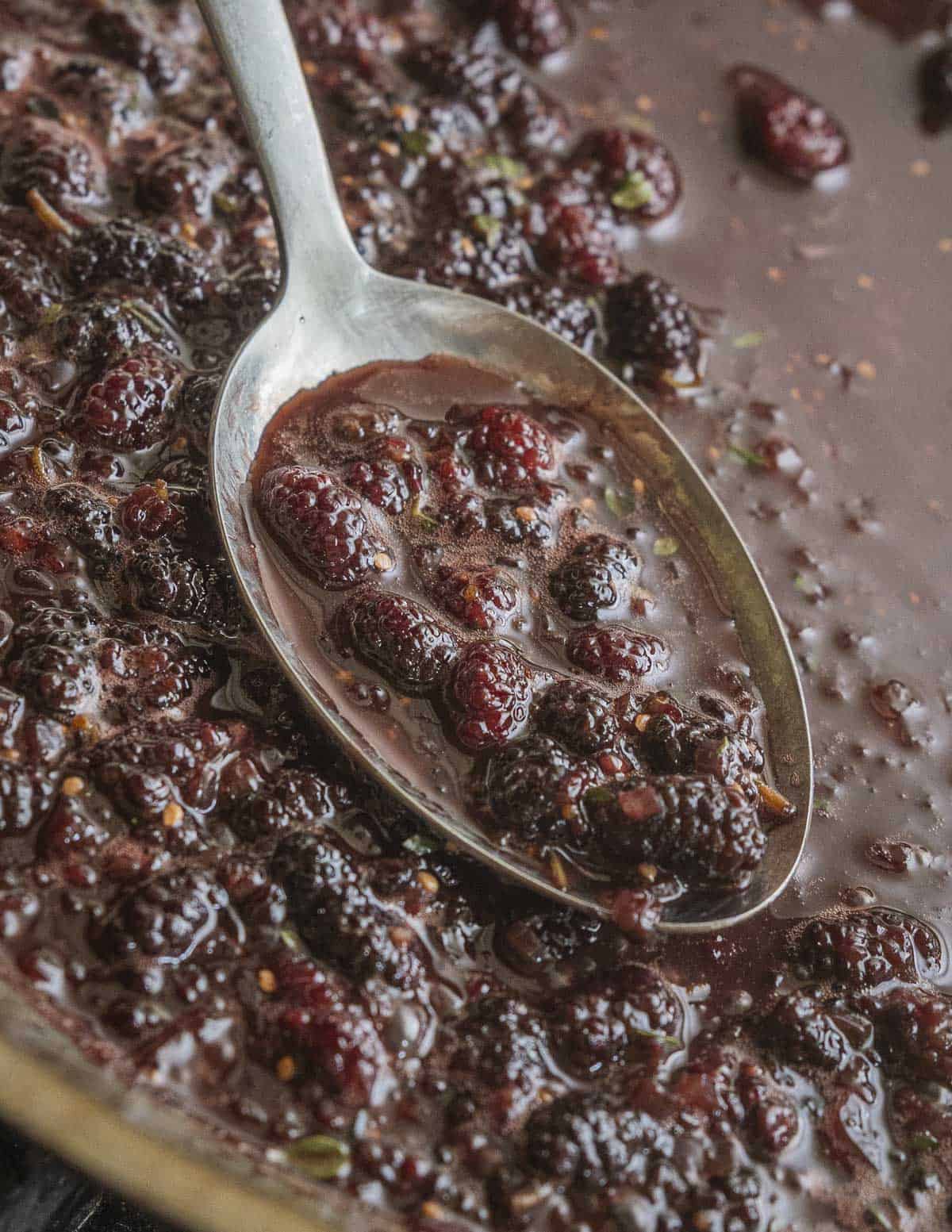
How to Make it
Season a chicken breast with salt a few hours before cooking or overnight. Below I'm cutting an airline breast, which is like a mini-roast chicken. You can also use boneless chicken, but it cooks much faster and should be dredged in flour before browning to keep it moist.
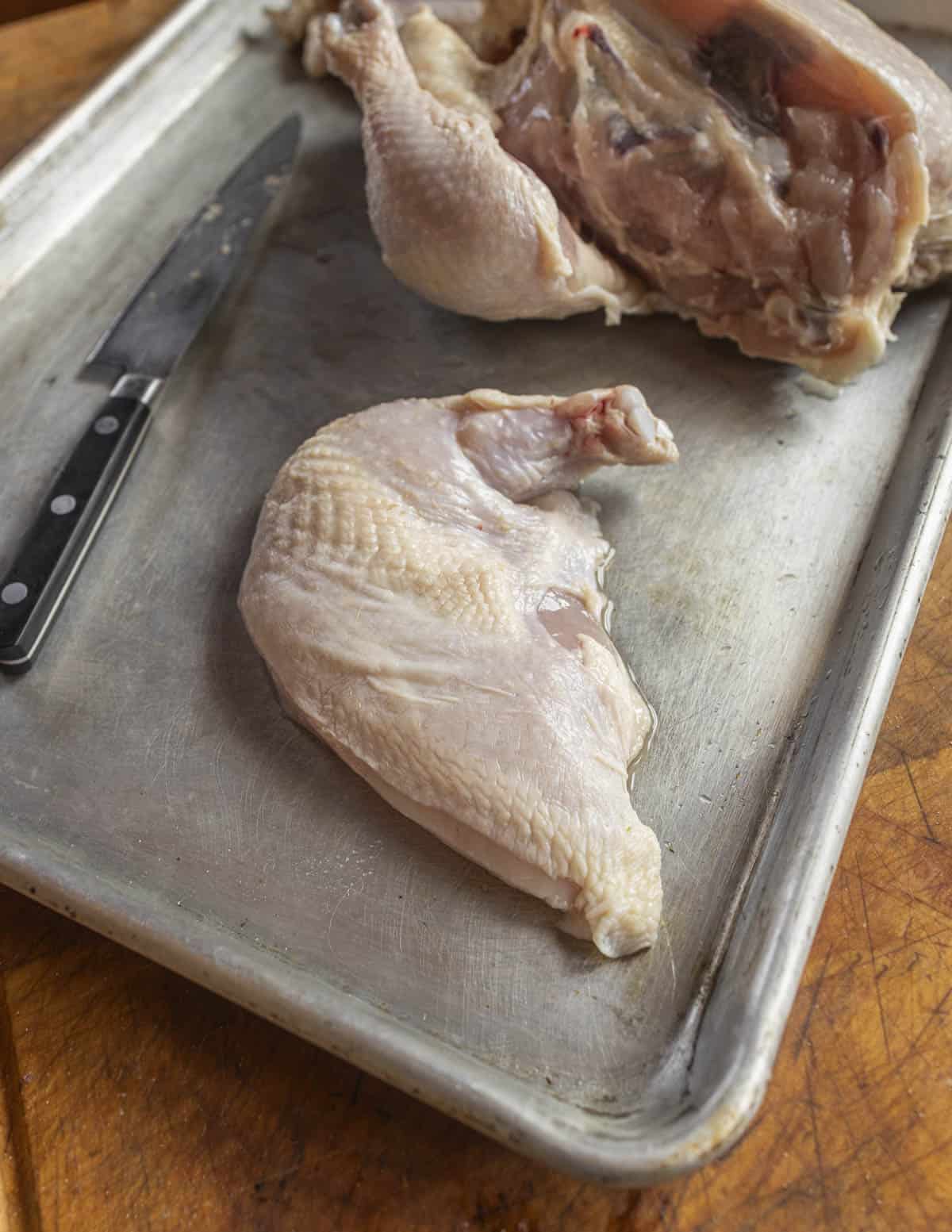
Heat some oil in a stainless steel saute pan or oven-safe skillet. When the oil begins to smoke, add the chicken skin-side down and put the pan in a preheated oven. After a few minutes you'll want to flip the chicken to ensure even cooking.
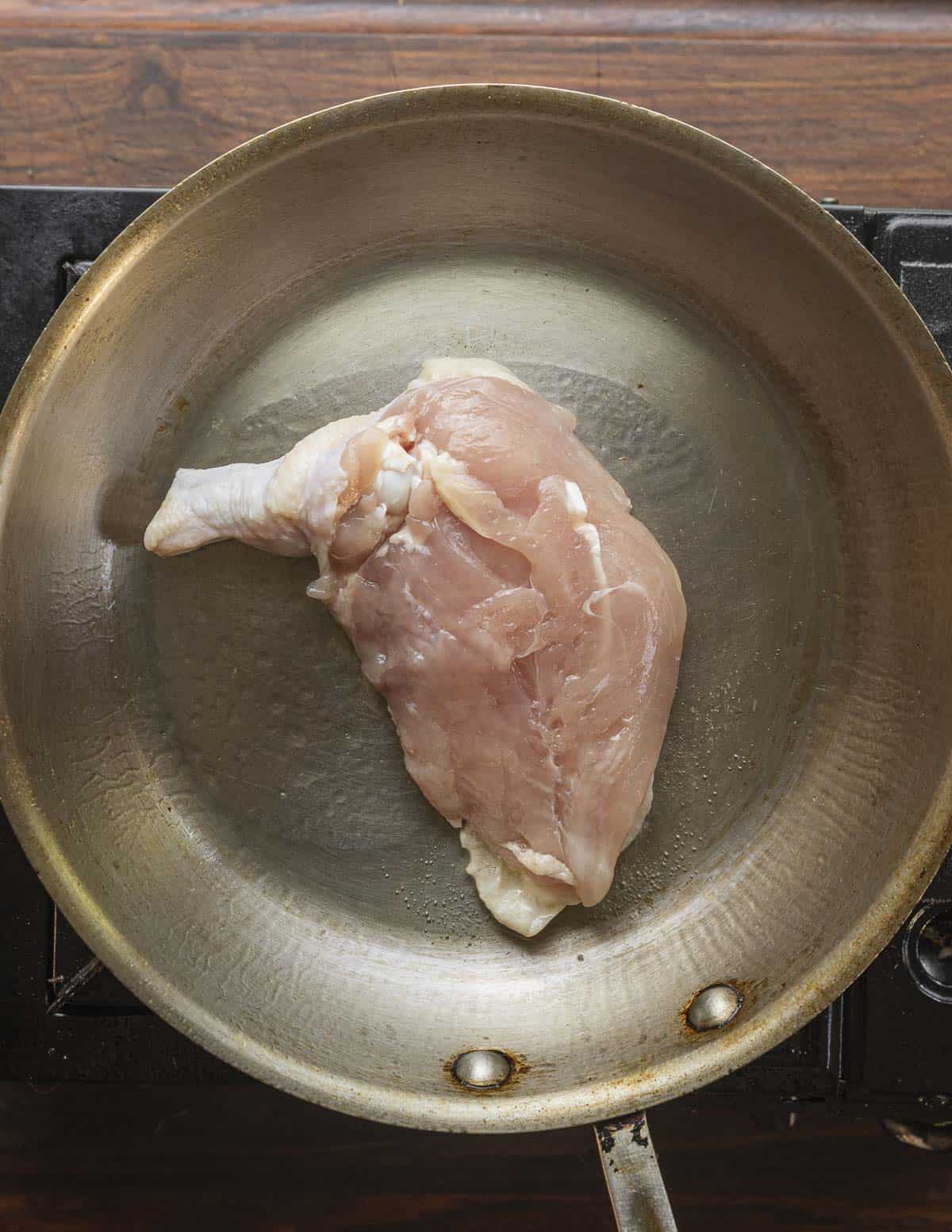
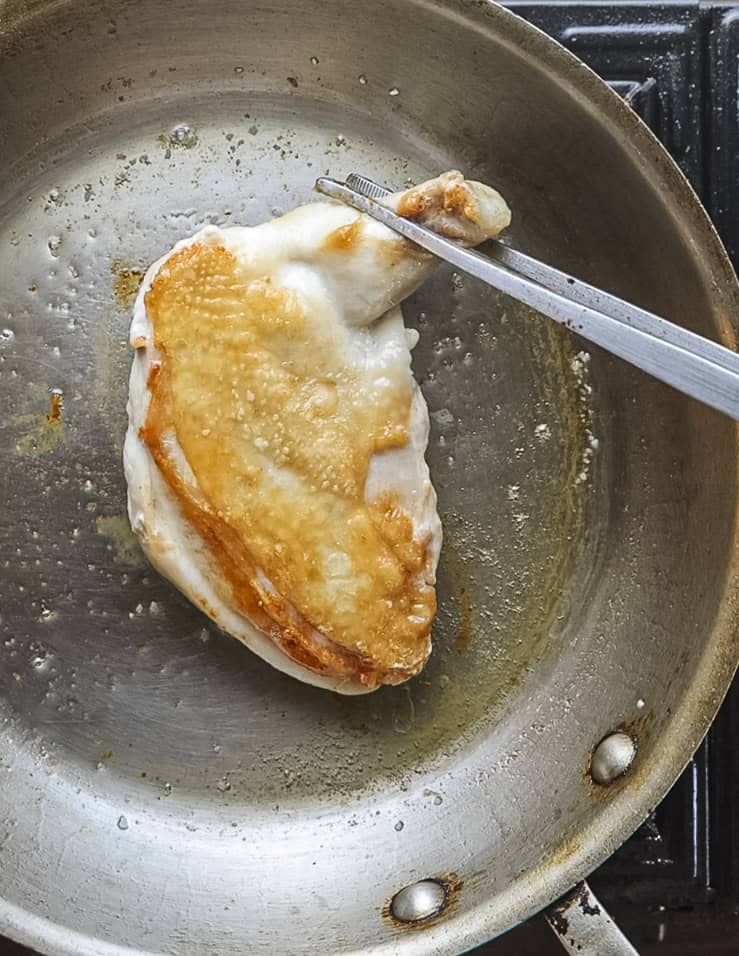
When the breast is nearly cooked, return it to the burner for a minute to get the skin perfectly brown. Remove it from the pan and allow it to rest while you make the sauce.
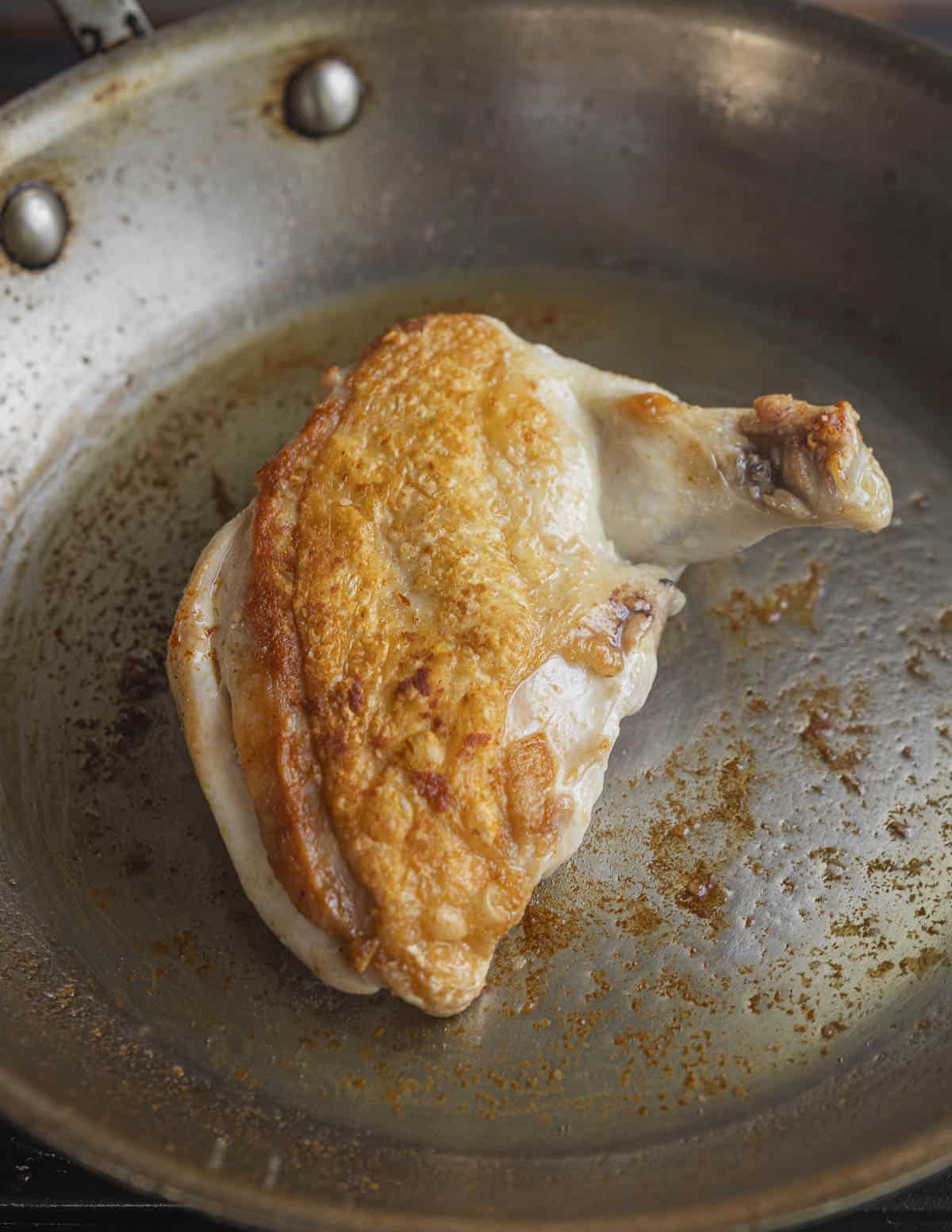
Add the shallots to the pan and cook for a minute, then deglaze the pan with the vinegar, wine and maple syrup. Reduce this down until syrupy, then add the mulberries and chicken stock and continue reducing.
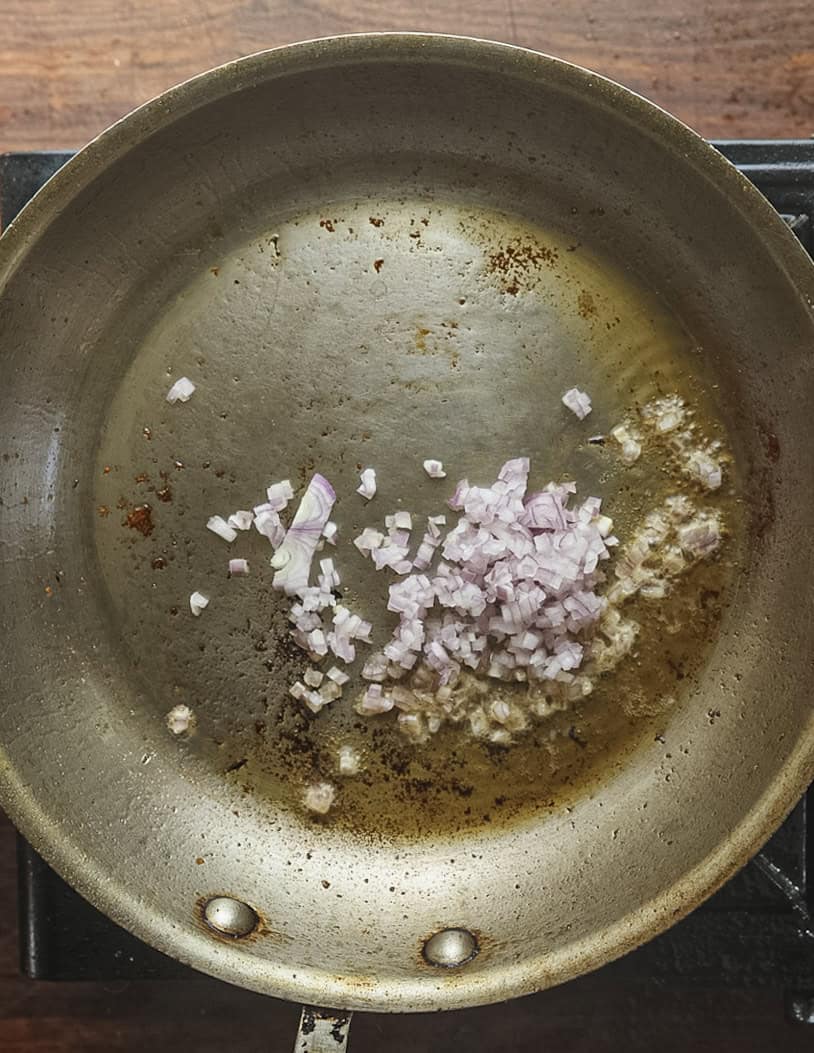

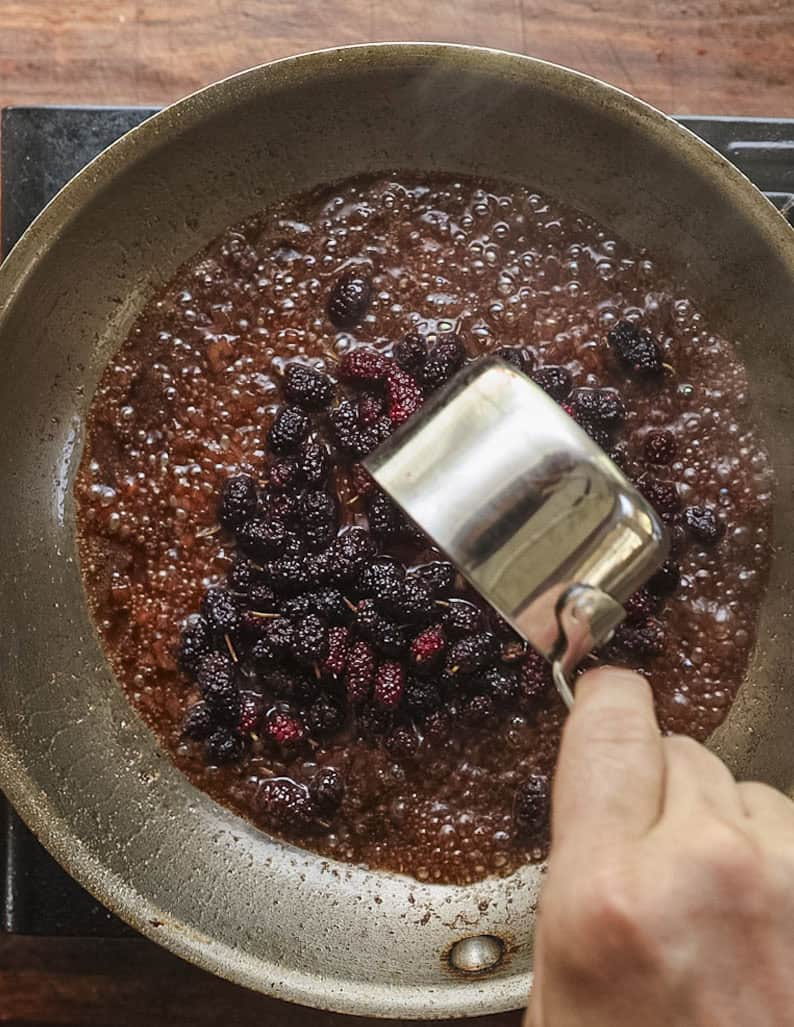
Crush the mulberries with the back of a spoon to release their juices. The better you crush them, the more spoonable the sauce will be. Add the butter and fresh thyme, stirring to incorporate the butter which will thicken the sauce.
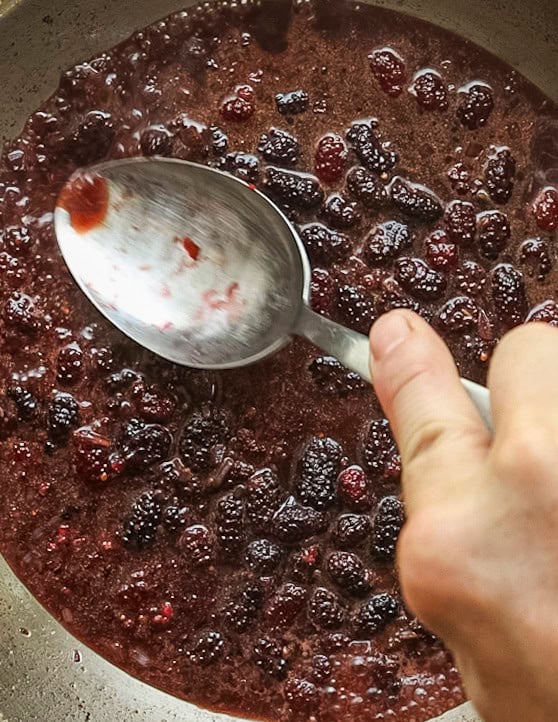
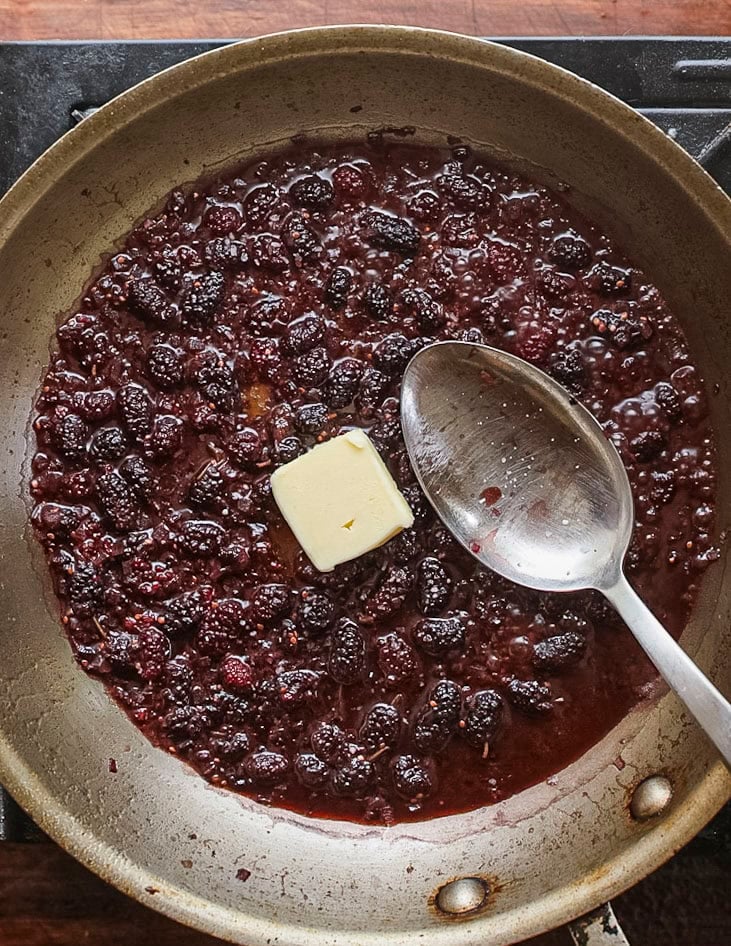
Reduce the sauce until it coats the back of a spoon and you can see the bottom of the pan when stirred. It should be thick enough to hold its shape on the plate. Think less sauce, more loose jam.
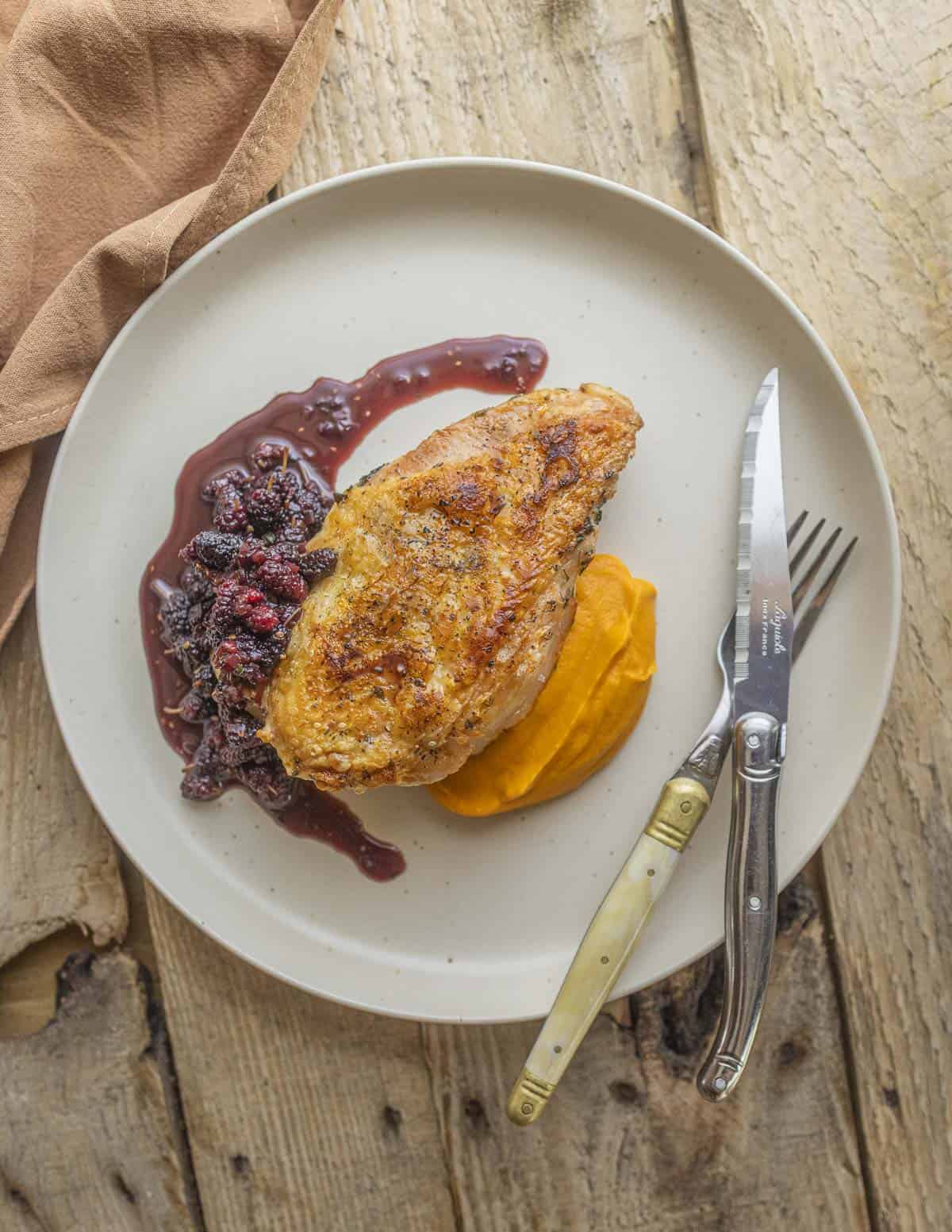
If you use boneless skinless chicken you can simmer the breast in the sauce to finish and serve it smothered with the sauce and berries. When the butter's emulsified and reduced it becomes a thick, shimmering glaze. In the past I've also added ground chipotle peppers and served the sauce with venison.
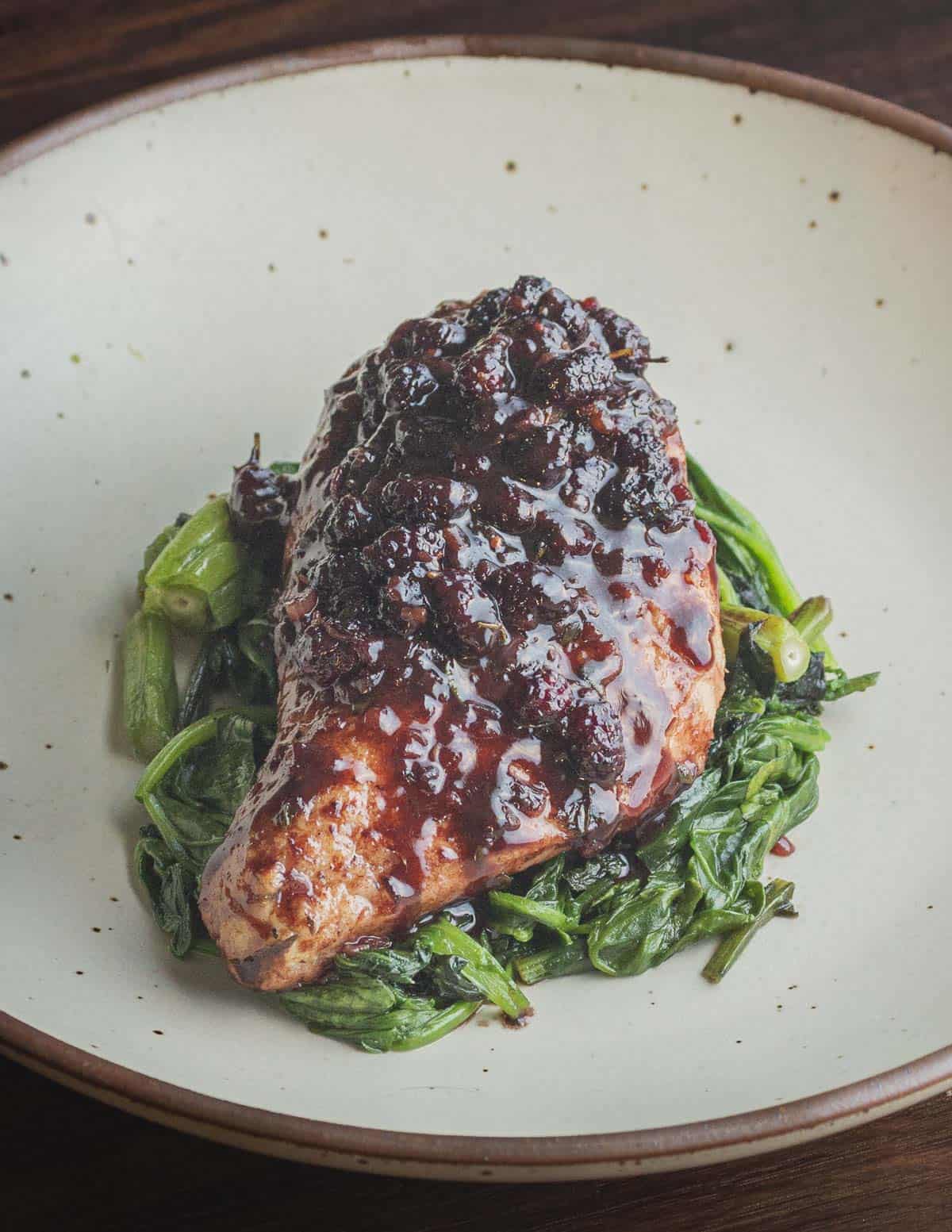
What do you serve alongside chicken with fruit sauce? Starchy root vegetables like parsnips, celery root, carrots and parsley root are great, especially as a thick dollop of puree.
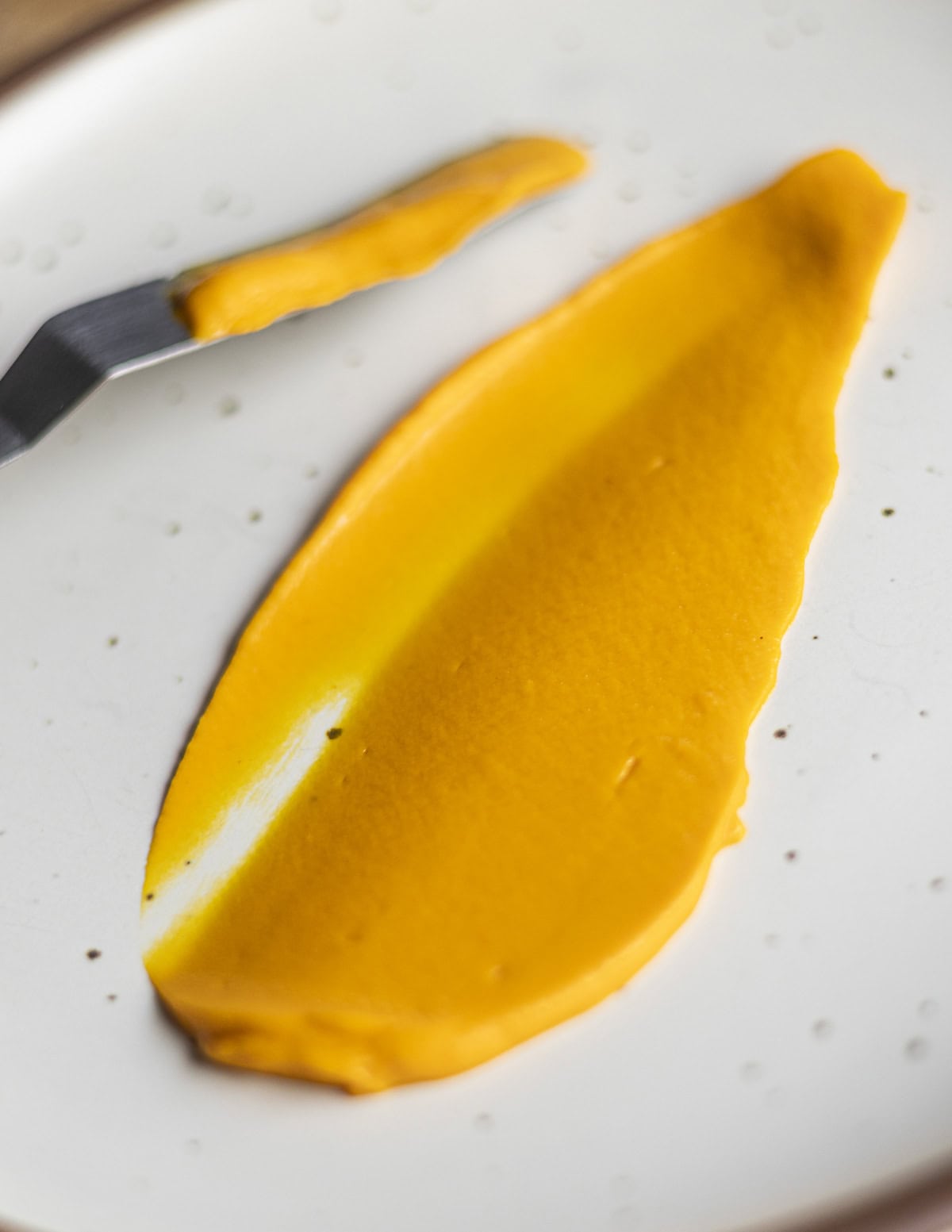
Here I've served it with a puree of carrots and ginger made using my recfipe for sunchoke puree. Dry side dishes like roasted root vegetables are good too, and even buttered greens like spinach or dandelions can work if they're well-drained and the sauce is tart enough.
Related Posts
Pan Roasted Chicken with Mulberry Sauce
Equipment
- 12 inch saute pan or large skillet 1 breast can be made in an 8 inch pan.
- Wide spoon for stirring and crushing berries
Ingredients
- 2 (8-10oz) Bone in, skin on chicken breasts for boneless skinless breasts, see recipe notes
- Kosher salt and fresh ground black pepper
- 1 Tablespoon cooking oil
- 1 cup fresh mulberries
- 1 teaspoon chopped fresh thyme or lemon thyme plus a few leaves to garnish
- ¼ cup dry red wine
- ¼ cup homemade mulberry vinegar, other fruit vinegar, or balsamic vinegar
- 2 Tablespoons unsalted butter
- 1 Tablespoon maple syrup
- 1-2 teaspoons whole grain or dijon mustard (optional, just a touch)
- 1 large shallot halved and cut into very fine dice, or just finely chop it
- 2 Tablespoons demi-glace (Optional, not many people will have this)
- ½ cup chicken stock preferably homemade and collagen-rich
Instructions
Bone in Chicken Breast or Skin On
- Preheat the oven to 400F. Season the chicken with salt and pepper and allow to rest in the fridge overnight, uncovered.
- In a large skillet, around 12 inches wide, heat the cooking oil until nearly smoking. Add the chicken breasts, skin-side down, then transfer the pan to the oven. Single breasts can be cooked in a 10 inch pan.
- Cook the chicken until 150F in the thickest part of the breast, this should take about 15 minutes. Fiip the chicken at the half-way point to avoid cooking the meat closest to the pan.
- Remove the pan from the oven and put it back on the burner. The breast should easily remove from the pan and should not stick if your heat was high enough. Cook the chicken for another minute or two, skin-side down to get the skin as golden brown as you can without burning it.
- Remove the chicken and allow to rest in a warm place while you prepare the sauce.
- Add the shallots to the chicken drippings and cook until translucent, about a minute. Add the vinegar and wine, bring to a boil and reduce until the pan is nearly dry.
- Add the mulberries, maple syrup and chicken stock and reduce by half. While you make the sauce, crush the berries up with the back of a wooden spoon to make them more homogenous and lend their juice to the sauce. Turn the heat down to a simmer (medium).
- When the sauce is reduced by half add the butter, stirring rapidly or whisking until it’s completely absorbed. Add the lemon thyme or thyme and tiny squeeze of fresh lemon juice.
- Taste and adjust the seasoning for salt and pepper until it tastes good to you. The sauce should be slightly tart, and thick enough to hold its shape on a plate.
- Arrange the chicken on each of two preheated dinner plates, spoon the sauce haphazardly over the top of the breast, allowing it to cascade on the plate so it doesn’t make the chicken skin soggy.
Video
Notes
- Preheat the oven to 300 F. Season and dredge the chicken in flour, tap off the excess and brown in oil on both sides.
- Remove the chicken while you make the sauce starting at step 5, undercooking the chicken slightly.
- Add the chicken back to the sauce and bake until it reaches 150 F, about 5-10 minutes.
- As the chicken cooks in the oven, baste it occasionally with the juices, spooning the mulberries on top, crushing them in the pan and cooking down to a thick glaze.
- Once the chicken is just cooked through remove the pan from the oven and allow to rest on the stove while you heat up a side dish and serve.

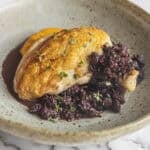
aaron
can we get the mulberry vinegar recipe too please, this is great!
Alan Bergo
Hi Aaron, of course! It’s linked in the text. It’s my recipe for fruit scrap vinegar on this site.
Thea
Mouthwatering video. Too bad I cut down all the “junk“ volunteer mulberries in my garden! This is definitely incentive to do some urban foraging.
Alan Bergo
Thanks Thea.